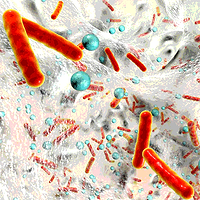Each year, foodborne illness costs the U.S. economy between $5 billion and $22 billion in lost productivity, hospitalization, long-term disability, and even death. The Centers for Disease Control and Prevention estimates that foodborne diseases cause approximately 76 million illnesses, 325,000 hospitalizations and 5,000 deaths in the U.S. each year. As a food processor, strict adherence to good manufacturing practices such as proper employee hygiene, adequate training, and effective cleaning and sanitizing of processing environment and equipment is the first line of defense against the costly, and sometimes fatal, effects of foodborne pathogens.
However, to ensure maximum food safety protection from raw material contamination and post-processing contamination, additional antimicrobial measures should be adopted to diminish or eliminate the risk of pathogens at critical control points throughout the production cycle. Among the most serious foodborne pathogens affecting the food processing industry is Listeria monocytogenes, which is found in soil, water, dairy products, raw and uncooked meat, poultry, seafood and contaminated produce, resulting in listeriosis-—a serious disease affecting pregnant women, newborns and adults with weakened immune systems. Listeria monocytogenes is spread very easily by direct contact between food and a contaminated surface. It can grow under low-oxygen conditions; at low refrigeration temperatures; and survives for long periods of time in the environment and on foods.
Because of these hazards, the U.S. Department of Agriculture’s Food Safety and Inspection Service (FSIS) designed regulations to encourage ready-to-eat (RTE) meat and poultry processors to employ more effective Listeria control measures. The rule mandates that establishments incorporate one of three strategies to control the pathogen:
• Alternative 1: Employ both a post-lethality treatment and a growth inhibitor for Listeria on RTE products. Establishments opting for this alternative will be subject to the least FSIS verification activity.
• Alternative 2: Employ either a post-lethality treatment or a growth inhibitor for Listeria on RTE products. Establishments opting for this alternative will be subject to more frequent FSIS verification activity than for Alternative 1.
• Alternative 3: Employ sanitation measures only. Establishments opting for this alternative will be targeted with the most frequent level of FSIS verification activity. Within this alternative, FSIS will place increased scrutiny on operations that produce hotdogs and deli meats. In a 2001 risk ranking, FSIS and FDA identified these products as posing the highest for illness and death.
The Right Antimicrobial for the Battle
One antimicrobial system proven effective in helping to control foodborne pathogens, including Listeria, is the SANOVA® program from Ecolab (www.ecolab.com). The SANOVA program currently is used in more than 100 large food processing plants across the U.S. that process poultry, red meat, fruits and vegetables. The SANOVA program has FDA/FSIS clearance as a secondary direct food additive for deli meats, frankfurters, sausages, meatloaf, stew meat and other cooked meat products, helping processors satisfy post-lethality invention requirements for Listeria reduction on ready-to-eat (RTE) product surfaces. A 1.3 log reduction was achieved on smoked turkey.
The SANOVA program has also received clearance as a secondary food additive for pathogen reduction on finfish and crustaceans, as well as for use in the RTE food processing industry. It can be applied at multiple intervention points in the process as a spray or dip.
As an in-line, antimicrobial food surface treatment, the SANOVA program helps break the contamination cycle without interrupting plant operations. It is classified by USDA as a processing aid, and so no additive labeling is required for processors. SANOVA is not for use as a hard surface food contact sanitizer.
It has delivered strong results in the following food processing environments:
• Red meat carcasses treated with products in the SANOVA program reduce E. coli counts greater than 90% on a consistent basis.
• Jensen Meat’s of Vista, CA, achieved a 100% reduction of E. coli on 50/50 blend of red meat parts and trim with the SANOVA program.
• Residual populations of E. coli on inoculated beef cuts were significantly reduced with the SANOVA program, with a proven 2.7 log reduction on 30-second exposure (99.6%).
• Poultry carcasses treated with a 15-second application of SANOVA acidified sodium chlorite solution deliver a less than 10% incidence of Salmonella on a consistent basis, outperforming the USDA standard.
• Salmon fillets treated with a SANOVA acidified sodium chlorite dip experienced a significant decrease in the initial microbial populations and a significant increase in shelf life from 14 to over 18 days.
• Treated whole fish, followed by treatment of the fillets increased the shelf life from 14 to over 22 days. Informal organoleptic observations confirm that untreated fillets were undesirable at 14 days, while treated fillets were still desirable at 22 days.
The SANOVA program is a versatile, highly effective in-line antimicrobial food additive treatment used as part of a total multiple intervention program that includes rigorous cleaning and sanitizing, personnel hygiene systems, and pest elimination.
ecolab.com
Winning the War Against Foodborne Pathogens




